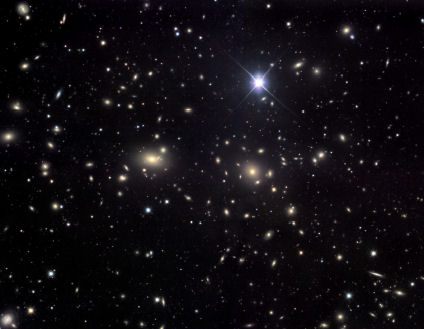Dark Matter
Since the early half of the 20th century astronomers have been baffled by the motion of certain stars that previously they had thought they understood. Fritz Zwicky, an astronomer in the 1930's, analyzed a cluster of galaxies and noticed that not only were they buzzing around each other like a swarm of bees, but moving abnormally fast. If a bee is on a CD spinning around, the bee has to hang on for dear life, or else he will be flung off the disc. By hanging on he is, from an outside point of view, in fact pulling himself inward, keeping in a circular motion around the circumference of the CD. Fritz Zwicky's galaxies were those clinging bees. The force of gravity is what keeps those galaxies from flying apart from one another under normal circumstances. However the galaxies that Zwicky surveyed did not seem to have enough gravity to keep them from flying away from the hive! If there is not enough visible mass in the cluster of galaxies to keep them together, is there something missing? This stuck out as an almost impossible answer to astronomers. In the 1960's Vera Rubin and others presented evidence for the existence of large amounts of unseen matter. Then in 2006 Douglas Clowe and his team presented evidence of this "dark" matter by analyzing the Bullet Cluster of galaxies. Because the galaxy clusters themselves were colliding, they were being separated from the dust that permeates them, dust which happens to make up a significant portion of their mass. Creating a map of the area showed that two large wells of gravity existed completely independent of the actual galaxies. Gravitational effects have led Astronomers to estimate that the majority of the matter in the Universe is of an unknown form that is not detected directly with telescopes. The existence of dark matter also comprises an important part of leading theories of the original formation of galaxies and their subsequent evolution, as well as the anisotropic structure of the cosmic microwave background. MACHO's and WIMP's So where is the "missing mass" hiding? Modern attempts to resolve the mystery divides researchers mostly into two camps; the MACHO's and the WIMP's. The first acronym stands for Massive Compact Halo Objects. These researchers are trying to determine if the halo of material surrounding our galaxy might contain lots of Jupiter-sized objects, or other forms of normal matter that is hard to detect. At that distance these objects would be too small and too dim to see, but if there are enough of them their gravity would make a difference. The second acronym stands for Weak Interacting Massive Particles. These researchers are investigating the possibility that the galaxies are filled with exotic subatomic particles that constitute the missing mass. So far, the evidence for WIMP theories is generating the greatest level of confidence from the scientific community as our most likely avenue to understanding dark matter. Some competing theories have been presented that attempt to reconcile observations without the existence of dark matter. These include alternative theories of gravity, and explanations from the perspective of quantum mechanics. There are significant problems that will have to be overcome for these alternatives to gain general acceptance. For now, the most accepted conclusion is that dark matter is real. The history of dark matter is still unfolding. Much of the science is new and every year more data is flowing in, from orbiting infrared telescopes, to deep underground laboratories hunting for exotic particles.
Source: Scott Burger, Western Washington University Dept of Physics & Astronomy
|

